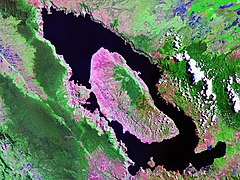NASI JAGUNG, Variasi Pengganti Beras
Selasa, 03 Juli 2012
 |
| NASI JAGUNG |
SURABAYA - Mungkin beberapa saat pernah terlintas di pikiran kita, betapa jenuhnya menatap ke atas piring makanan kita, dan menemui fakta bahwa di sana (lagi - lagi) terhidang Nasi Putih. Makanan pokok yang memang sudah sangat tidak asing bagi kita sehari - hari. Entah sudah berapa hari kita menjejakkan kaki di atas dunia ini, dan sejak saat itu pula petualangan kita akan Nasi dan Beras terus terjaga bahkan hingga tiga kali sehari.
Tapi apakah pernah terlintas di pikiran kita, dan kita berandai - andai kalau sesekali yang terhidang di atas piring kita bukan Nasi lagi, melainkan sesuatu yang berbeda?
Mungkin setelah sebelumnya saya membahas tentang Sego TIWUL, tidak ada salah nya jika saya juga membahas tentang salah satu alternatif makanan pokok selain Beras / Nasi yakni Sego JAGUNG yang terkenal dengan berbagai nama. Mungkin di antara beberapa makanan pokok alternatif lainnya, kita lebih familiar dengan Nasi Jagung yang juga sering disebut dengan sebutan Sego / Nasi Empog.
Dan Nasi Jagung lebih mudah kita jumpai di lingkungan kita, bahkan tidak jarang penjual Nasi juga banyak menjual Nasi Jagung yang sangat nikmat ketika disantap hangat mengepul ini. Biasanya
sayur yang lazim ditemui bersanding dengan menu Nasi Jagung adalah urap sayur, tumis terong, tumis lodeh,
atau tumis cabe hijau. Sedangkan lauknya adalah ikan asin, dan rempeyek teri.
Jika kita berbicara tentang kelezatan, dan menu Nasi Jagung, gambaran seperti yang di atas itulah yang akan kita temui. Tetapi apakah kita tahu sejatinya kandungan gizi apa saja yang terkandung di dalam Nasi Jagung yang saya sebut sebagai salah satu bahan makanan alternatif pengganti Beras ini?
Berdasarkan
data dari Direktorat Gizi Departemen Kesehatan, Jagung Giling Kering ternyata memiliki keunggulan gizi apabila dibandingkan dengan Beras (nah lohhh....), walaupun tidak bisa dipungkiri pula bahwa Jagung memiliki kandungan Karbohidrat yang sedikit lebih rendah apabila dibandingkan dengan Beras. Ternyata Karbohidrat sebanyak 72,4 gram terkandung dalam setiap 100 gram Jagung Giling,
sedangkan Beras memiliki Kandungan Karbohidrat sebesar 78,9 gram (berbeda sekitar 6,5 gram).
 |
| JAGUNG GELONDONGAN |
Apabila kita memperhitungkan kandungan Protein di dalam Jagung Giling, pada takaran sama Jagung Giling mengandung 8,7 gram
protein, sementara beras giling mengandung 6,8 gram protein. Dari sini bisa diambil kesimpulan bahwa mengkonsumsi Jagung ternyata tidak mengurangi asupan gizi di dalam tubuh kita, malah,
mengonsumsi Sego Jagung sebenarnya jauh lebih baik daripada Beras karena gizinya
lebih lengkap.
Selain
sebagai sumber utama Karbohidrat, bahan pangan pokok yang sering
diidentikkan sebagai makanan pokok orang Madura ini mengandung zat gizi
lain seperti: Energi (150,00 kal), Protein (1,600 g), Lemak
(0,60 g), Karbohidrat (11,40 g), Kalsium (2,00 mg), Fosfor (47,00 mg), Serat
(0,40 g), Besi (0,30 mg), Vit A (30,00 RE), Vit B1 (0.07 mg), Vit B2 (0,04 mg),
Vit C (3,00 mg), Niacin (60 mg).
Itulah kehebatan Sego Jagung yang
mungkin juga identik sebagai jajanan dibandingkan sebagai makanan pokok
(melengkapi anggapan umum orang Indonesia bahwa: "Makan belum kenyang tanpa kehadiran Nasi").
Di luar sederetan kandungan gizi yang saya sebutkan di atas, ternyata
Jagung Giling juga telah diteliti secara seius oleh Dunia Medis. Bahkan
mengkonsumsi Nasi Jagung / Jagung Giling disinyalir merupakan dapat
membangun serta memperkuat Otot dan Tulang. Nasi Jagung juga memberikan asupan gizi yang baik bagi otak dan sistem syaraf serta dapat mencegah
konstipasi.
Dengan segenap kelebihan penting di
atas, mengkonsumsi Nasi Jagung ternyata juga bisa menurunkan resiko
penyakit kanker, dan jantung, dapat mencegah gigi berlubang, dan minyak
yang terkandung di dalam Nasi Jagung dapat menurunkan kandungan
kolesterol di dalam darah. nahh.... Nasi Jagung pun bisa diperhitungkan
sebagai makanan pokok pengganti Beras bagi penderita Diabetes, karena kandungan Karbohidrat Nasi Jagung lebih rendah daripada Nasi Putih / Beras sehingga kadar gula darah dapat terkontrol.
Hebat kan salah satu makanan pokok khas
nenek Moyang kita ini. Mungkin tidak ada salahnya jika kita mengikuti
pola makan orang Desa yang masih memegang teguh kebiasaan Lama ini.
Orang Desa terbiasa untuk memberikan variasi dalam menu sehari - hari
mereka, mereka tidak seperti orang kota yang melulu memakan Nasi Putih
sehari - harinya. Orang Desa terkadang mereka bervariasi dengan
menghidangkan Nasi Tiwul, Nasi Jagung, bahkan Gatot (akan saya bahas di artikel berikutnya),
saya sendiri menyaksikan bagaimana dalam 1 minggu mereka bisa mem -
variasi makanan - makanan itu menjadi makanan pengganti Beras. Bahkan
saya sendiri yang memang berasal dari salah satu Kota Kecil (Lumajang), dan sangat sering menginap di desa, lebih menikmati variasi makanan ini.
Dan memang tidak bisa dipungkiri,
bahwa secara kesehatan fisik, dan bentuk fisik, masyarakat Pedesaan yang
sering mengkonsumsi makanan secara bervariasi lebih bagus apabila
dibandingkan masyarakat perkotaan yang melulu menyantap Beras / Nasi
Putih sebagai menu harian mereka.
Apakah Anda berminat untuk mencoba Tips Makanan Pokok Alternatif ini?




















